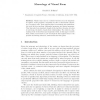Free Online Productivity Tools
i2Speak
i2Symbol
i2OCR
iTex2Img
iWeb2Print
iWeb2Shot
i2Type
iPdf2Split
iPdf2Merge
i2Bopomofo
i2Arabic
i2Style
i2Image
i2PDF
iLatex2Rtf
Sci2ools
IWVF
2001
Springer
2001
Springer
Mereology of Visual Form
Visual forms come in countless varieties, from the simplicity of a sphere, to the geometric complexity of a face, to the fractal complexity of a rugged coast. These varieties have been studied with mathematical tools such as topology, differential geometry and fractal geometry. They have also been examined, largely in the last three decades, in terms of mereology, the study of part-whole relationships. The result is a fascinating body of theoretical and empirical results. In this paper I review these results, and describe a new development that applies them to the problem of learning names for visual forms and their parts.
| Added | 30 Jul 2010 |
| Updated | 30 Jul 2010 |
| Type | Conference |
| Year | 2001 |
| Where | IWVF |
| Authors | Donald D. Hoffman |
Comments (0)

